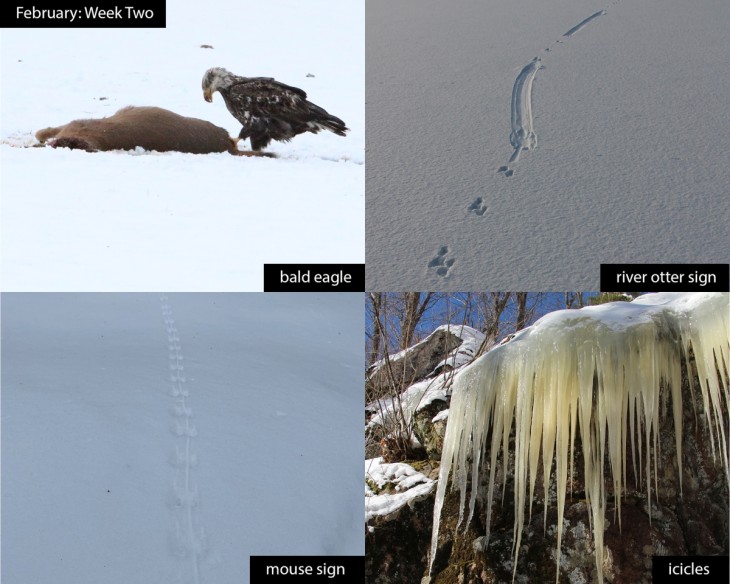This week in the woods, we spied an immature bald eagle picking at a deer carcass on a frozen roadside pond. The United States’ newly designated national bird doesn’t always have its familiar snow-white head, uniformly dark body, and yellow beak. For the first four or five years of life, they have the dark-brown plumage displayed here, with irregular white spots over wings and body, and a gray bill going yellow over time. Bald eagles prefer to eat fresh fish (plucked from the water’s surface or stolen from ospreys) and predate small mammals and large birds, but carrion factors prominently in their winter diets. While this deer likely perished after slipping and falling on the ice, scavenging bald eagles risk lead poisoning from lead bullets in unrecovered hunting kills or discarded gut piles, as well as lead fishing tackle. (For more on bald eagles in winter, see Meghan McCarthy McPhaul’s Outside Story from 2019, and for more on “Awkward Adolescent Eagles,” see Elise Tillinghast’s Outside Story from 2015.)
On another frozen pond, in West Fairlee, Vermont, we encountered a more cheerful scene: signs of a river otter running and sliding. While otters spend much of the winter under ice cover foraging for fish and other aquatic prey, they travel aboveground between waterbodies to access sufficient food. For efficient movement along their often miles-long circuits of sites, the long, sleek members of the weasel family sometimes run, tuck their front feet to their chest, and push off with their hind legs to glide on snow or ice. Mary Holland noted similar impressions the week before last on her Naturally Curious blog; she writes of otter sliding, “Energy is saved, travel is fast, and it just has to be fun.”
In Sugar Hill, New Hampshire, Editor Meghan McCarthy McPhaul observed more evidence of snowy travel with these mouse tracks. The zipper pattern of tail drag and bounding four-foot impressions indicate that either a deer mouse or white-footed mouse made these prints; meadow voles travel more often below snow, but when they leave the subnivean zone, they make varied prints, with less regular tail marks and only a single pair of foot impressions at a time.
Icicles form in a familiar process of singular drops from melting snow or underground seeps dangling from objects in subfreezing air and refreezing one upon another. Minerals leached from the ground on wooded cliffsides such as this one or dynamited highway cuts can produce varied colors and rippling patterns less common in the ice on building overhangs. Growing as fast as a centimeter per minute with the right conditions, icicles can develop and transform over the course of an afternoon.
What have you noticed in the woods this week? Submit a recent photo for possible inclusion in our monthly online Reader Photo Gallery.


